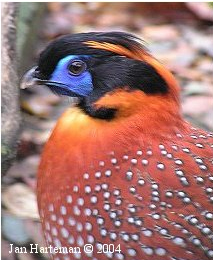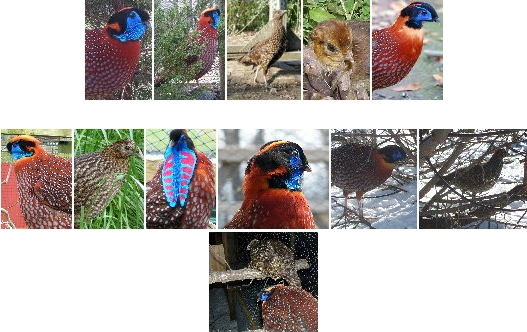 Other Names: Crimson Bellied Tragopan, Chinese Crimson Pheasant, Temminck’s Horned Pheasant
Other Names: Crimson Bellied Tragopan, Chinese Crimson Pheasant, Temminck’s Horned Pheasant
Range: The most widespread of the genus, this Tragopan is found in northeastern India through Myanmar (Burma) to northern Vietnam north to central China.
Subspecies: None recognized.
Habitat: Forests, dense evergreen, bamboo and rhododendron.
Description: The head is black, forming a mask around the blue facial skin that is extended during courtship; deep orange-red on crest, neck and breast; some males with bright orange collar; rest of body crimson, covered with gray spots on lower breast and black-lined white spots on wing coverts, back and upper tail coverts. Compared to the similar Satyr Tragopan, tail shorter, underparts grayer, overall lighter and more extensive facial skin.
Description, female: Upper parts varying from rufous to greyish brown, never as reddish as in some satyra, nor as grey as in caboti, strongly mottled with blackish, with arrow-shaped mark of pale buff to greyish white; chin and throat buff to whitish, with black lines; under parts light brown with large whitish spots and black patches.
Avicultural Data
Status in Aviculture: Well established; the most commonly seen of the genus in captivity. A 2004 survey showed the Temminck’s Tragopan to be the one of the most popular and commonly kept pheasant species in North America.
Breeding Season: Late April through June.
Breeding Age: Second year, although first year hens may lay fertile eggs if kept with an older male. Elevated nesters.
Clutch Size: 3-6
Incubation Period: 28 days



